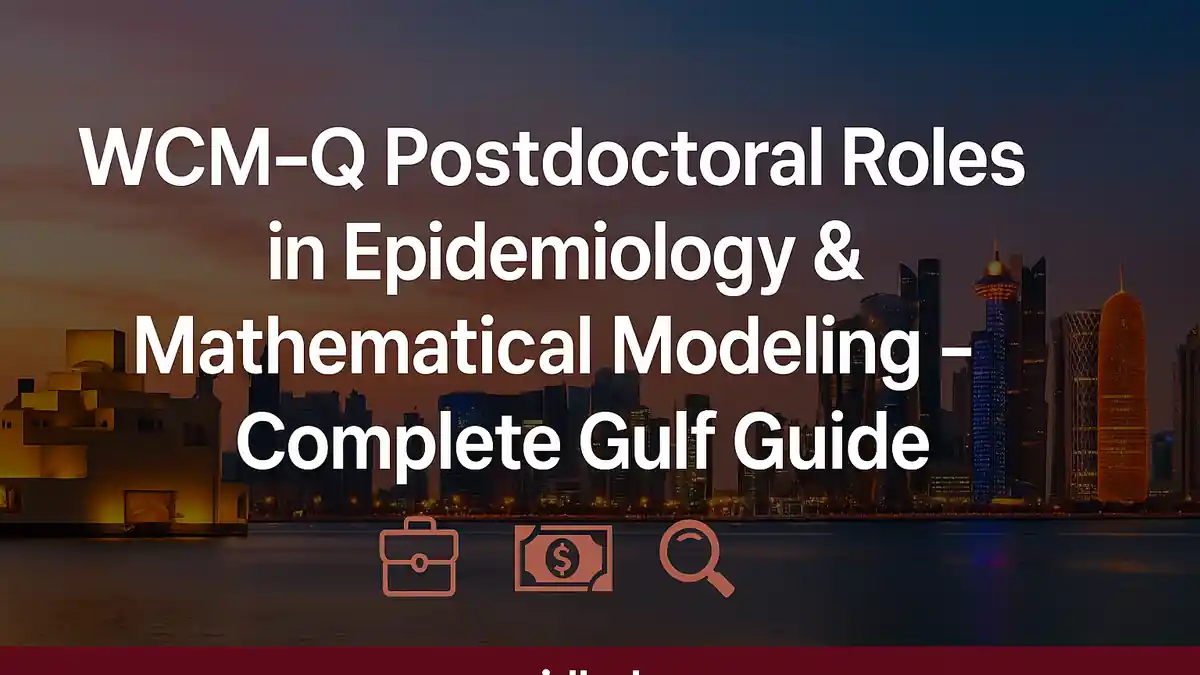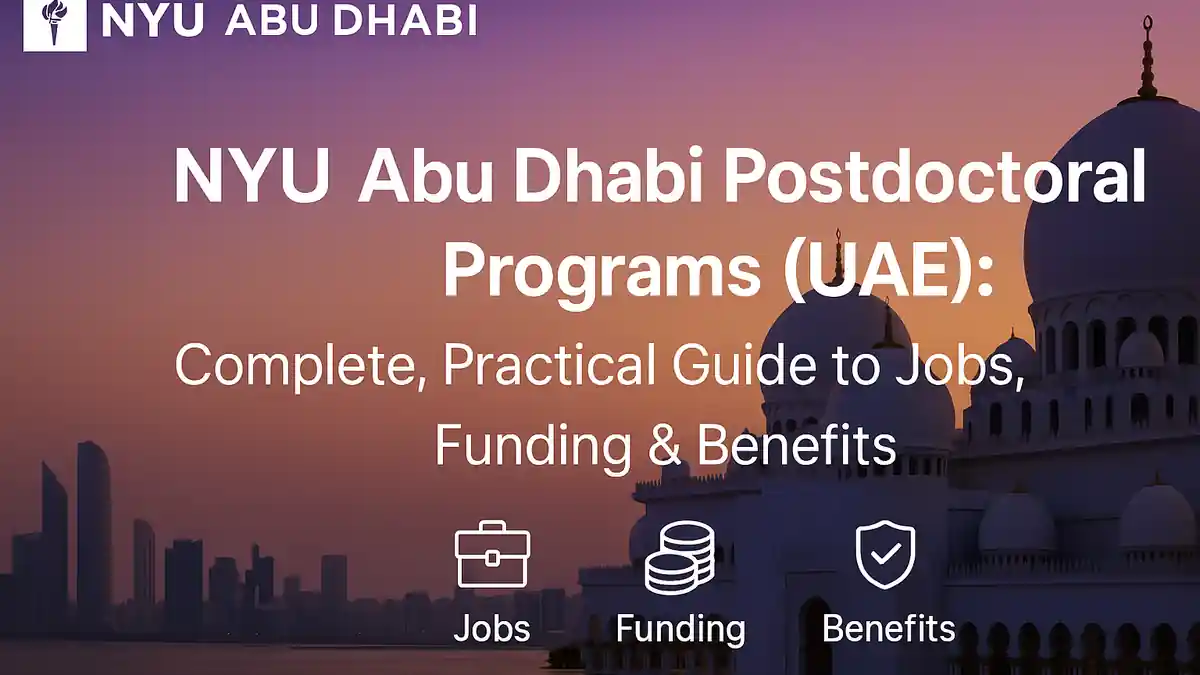Introduction: Why WCM-Q Suits Quantitative Postdocs
WCM-Q is a robust destination for researchers who convert data into public-health decisions. The institute advertises lab-embedded positions with clear modeling and epidemiology mandates, supported by modern infrastructure and collaborations. Moreover, applicants can target teams that routinely publish, brief stakeholders, and share methods across disciplines.
Aim for a lab-based postdoc in the Gulf with strong quantitative impact? Weill Cornell Medicine–Qatar (WCM-Q) hosts leading teams in infectious-disease epidemiology and mathematical modeling, offering data-driven projects, policy-relevant outputs, and international collaboration potential. This guide shows where to find roles, how to apply, and how to excel.
What “Postdoc” Means at WCM-Q (and Why Titles Vary)
Titles sometimes read “Postdoctoral Associate,” and sometimes “Research Specialist (Epidemiology/Mathematical Modeling).” Although labels differ, responsibilities converge: you will analyze large datasets, develop models, co-author papers, and present results. Ultimately, the terminology reflects funding lines and HR classification rather than day-to-day scientific work.
Practical Reading of Titles
- Postdoctoral Associate: Academic postdoc contract with defined scholarly outputs.
- Research Specialist: Lab-based, postdoc-level analytics and modeling; publication expectations remain strong.
- How to decide: Prioritize the lab name, PI, and duties over thejob title.
The Lab to Watch: Infectious Disease Epidemiology Group (IDEG)
The Abu-Raddad Lab / IDEG anchors WCM-Q’s quantitative population-health research. The group examines transmission dynamics and intervention impact for HIV, viral hepatitis, tuberculosis, influenza, and other respiratory pathogens. Frequently, projects integrate surveillance databases with compartmental or Bayesian models to generate reproducible estimates for policy.
Methods You’ll See Frequently
- Deterministic and stochastic transmission modeling
- Bayesian hierarchical inference and calibration
- Evidence synthesis and meta-analysis
- Counterfactual estimation for screening, vaccination, and treatment programs
Fit signal: If your PhD centered on ODE models, likelihood-based inference, or causal frameworks, you can contribute immediately.
Where to Find Live Openings (and Verify Authenticity)
- WCM-Q job pages: Filter by Location: Qatar and search by lab or keywords (e.g., “Abu-Raddad,” “epidemiology,” “modeling”). Capture requisition numbers and submission deadlines.
- PI-driven notices: Occasionally, labs circulate postdoc ads via academic boards. Validate authenticity by ensuring the ad points back to WCM-Q channels.
- Security practice: Apply only through official application workflows or the email listed in the posting.
What You’ll Work On: Projects and Day-to-Day Tasks
Core responsibilities
- Build, calibrate, and validate models forcommunicable (and sometimes non-communicable) diseases.
- Clean, link, and analyze surveillance, cohort, or EHR-derived datasets; maintain reusable code.
- Run scenarios to quantify the effect of interventions; deliver policy-ready figures and briefs.
- Draft manuscripts, present findings, and coordinate multi-institution collaborations.
- Build, calibrate, and validate models for
Deliverables That Matter
- Manuscripts with transparent methods and code availability
- Reproducible pipelines (versioned in Git)
- Timely briefings translating R₀/Rt, averted cases, or cost-effectiveness into decisions
Profiles That Get Shortlisted
- Doctorate in epidemiology, biostatistics, applied mathematics, statistics, computational biology, physics, or related field.
- Toolkit: R or Python (plus MATLAB/Stan where relevant), ODE/agent-based modeling, uncertainty analysis, and Bayesian calibration.
- Synthesis: Meta-analysis or evidence integration across heterogeneous datasets.
- Collaboration: Clear writing, code documentation, and comfort in diverse teams.
Strengthen Your Case
Therefore, highlight two recent analyses with links to code or a data appendix. Additionally, show familiarity with best practices—unit tests, containers, and literate programming notebooks.
How to Apply (Step-by-Step)
- Collect postings and record requisition IDs, contacts, and submission windows.
- Map your fit to lab portfolios by naming disease areas and methods you will advance.
- Prepare documents: targeted CV; 1–1.5-page cover letter; a 12–24-month research plan with 3–4 milestones; and 2–3 key papers.
- Submit through official workflows exactly as the ad instructs; follow file-format andnaming rules.
- Track progress in a simple spreadsheet and set weekly reminders to check updates.
H3 — Writing a Persuasive Research Plan
- Define a problem statement grounded in regional or global burden.
- Specify data sources and modeling approach with calibration strategy.
- List expected outputs (paper, dataset, tool) and a timeline.
- Outline dependencies (co-mentors, data approvals, compute).
Compensation, Benefits, and Life in Doha
WCM-Q communicates a competitive package and supportive working environment. While specifics vary by contract, roles commonly include salary and institutional benefits; some offer relocation assistance and other allowances. Always verify details with HR before accepting an offer.
Living in Qatar: Researcher’s Snapshot
Doha is well connected, with reliable healthcare and schools, frequent regional flights, and a growing science ecosystem. Consequently, many postdocs appreciate the combination of international teams and policy-relevant public-health questions unique to the region.
How to Stand Out: A Four-Part Playbook
- Show immediate utility: Propose a quick win (e.g., recalibrate an existing model with new surveillance data and deliver Rt estimates).
- Demonstrate reproducibility: Share a public repo witha small, synthetic example and clear documentation.
- Connect to policy: Briefly describe one project where your estimates influenced a guideline or budget.
- Plan dissemination: Name two target journals and one conference; include a realistic Gantt for months 1–12.
Common Pitfalls (and Easy Fixes)
- Generic materials: Replace boilerplate with lab-specific aims grounded in their recent outputs.
- Over-promising: Frame ambition with feasible, time-boxed milestones.
- Code opacity: State testing, linting, and environment standards up front.
Current Signals of Activity
WCM-Q job pages regularly feature Abu-Raddad Lab opportunities in Epidemiology and Mathematical Modeling. Although exact titles vary, duties align with postdoctoral-level quantitative work. Accordingly, keep alerts on and revisit listings weekly; funding cycles refresh vacancies quickly.
Application Checklist
- Targeted CV with methods, software, and datasets
- Cover letter aligned to lab priorities
- 12–24-month research plan with milestones
- Links to code or a methods appendix
- Requisition IDs and submission confirmations
Feature Summary
Feature | Details |
Program Name | Weill Cornell Medicine–Qatar Postdoctoral Roles in Epidemiology & Mathematical Modeling |
Host Country | Qatar (Doha) |
Funded By | Weill Cornell Medicine–Qatar |
Duration | Typically 1–3 years (lab-dependent) |
Study Mode | Full-time, on campus (lab-based) |
Eligibility | PhD in relevant field; modeling and analytics experience; strong writing and collaboration |
Financial Support | Salary; institutional benefits; possible relocation assistance and allowances (contract-specific) |
Fields of Study | Epidemiology, Biostatistics, Mathematical Modeling, Public Health, Infectious Diseases |
Deadline | Rolling by vacancy; next cycles: Jan–Mar and Aug–Oct (we will update soon) |
Official Website | Click here |
Dates note: Based on historical posting patterns, expect clusters in Jan–Mar and Aug–Oct. Use monthly indicators only; update as new vacancies appear.
Conclusion: Where Quant Skills Meet Policy Impact
For researchers who want their models to inform real decisions, WCM-Q offers compelling lab environments, reproducible workflows, and policy-relevant questions. Therefore, start with the official openings page, assemble a targeted dossier, and propose a credible year-one plan. Then monitor listings regularly; vacancies refresh often. Official citation: [2]
References
[1] WCM-Q — Abu-Raddad Lab Open Positions
[2] Weill Cornell Medicine — Careers (Qatar listings included)
Frequently Asked Questions (FAQs)
Typically, you need a PhD, peer-reviewed publications, strong statistics/modeling skills, and programming in R or Python; moreover, clear fit with a WCM-Q lab strengthens selection.
First, search the official WCM-Q openings page. Then tailor your CV, cover letter, and research plan to the target lab. Finally, submit all documents through the portal.
You analyze surveillance datasets, build and calibrate transmission models, write manuscripts, and, additionally, present results for policy briefs while collaborating across clinical and public-health teams.
They are primarily on-campus and lab-based in Doha; however, cross-institution collaborations and occasional remote work may occur, depending on lab policy and project needs.
Most labs prefer R or Python; additionally, MATLAB, Stan, Git, containers, and reproducible pipelines help you deliver calibrated models and transparent, policy-ready analyses.
Yes. HR typically coordinates work authorization and relocation logistics; however, benefits vary by contract, so confirm specifics with the hiring unit during the offer stage.
Projects span infectious-disease dynamics, vaccination impact, screening strategies, and HIV, hepatitis, TB, and respiratory pathogens; consequently, you’ll combine big datasets with mechanistic or Bayesian models.
Openings appear year-round; nevertheless, many cluster around academic hiring seasons. Therefore, set alerts and check the careers portal weekly for new requisitions.
Demonstrate methodological fit, link to clean code repositories, propose a 12–24-month plan with milestones, and, moreover, highlight publications and prior policy-relevant deliverables.










